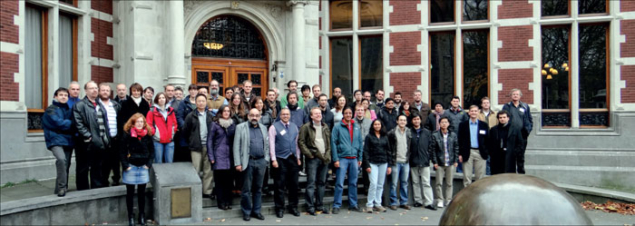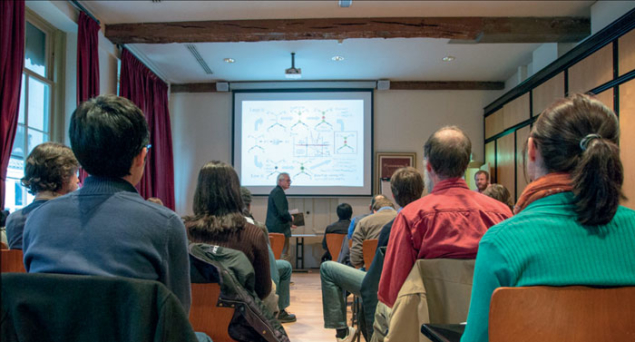Heavy flavours in the spotlight at an international workshop.

Image credit: Sarah LaPointe.
The historic academic building of Utrecht University provided the setting for the 5th International Workshop on Heavy Quark Production in Heavy-Ion Collisions, offering a unique atmosphere for a lively discussion and interpretation of the current measurements on open and hidden heavy flavour in high-energy heavy-ion collisions. Held on 14–17 November, the workshop attracted some 70 researchers from around the world, a third of the participants being theorists and more than 20% female researchers. The topics for discussion covered recent results, upgrades and future experiments at CERN’s LHC, Brookhaven’s Relativistic Heavy-Ion Collider (RHIC) and the Facility for Antiproton and Ion Research (FAIR) at Darmstadt, as well as theoretical developments. There was a particular focus on the exchange of information and ideas between the experiments on open heavy-flavour reconstruction.
Open and hidden heavy flavour
Representatives from all of the major collaborations nicely summarized recent experimental results and prospects for future measurements. In particular, with the advent of the LHC, an unprecedented wealth of data on the production of heavy quarks and quarkonium in nuclear collisions has become available. One of the more spectacular effects observed at RHIC is the quenching of the transverse momentum (pT) spectra of light hadrons, related to the energy loss of quarks inside the hot quark–gluon plasma (QGP) phase produced in lead–lead (PbPb) collisions. This has now been studied in detail for the first time by the ALICE, ATLAS and CMS collaborations in the heavy-quark sector.

Image credit: Ivar Pel.
Among the highlights presented at the workshop, the ALICE collaboration reported a strong suppression (up to a factor around 5) of the production of D mesons in PbPb collisions at a centre-of-mass energy, √sNN, of 2.76 TeV, compared with proton–proton data at the same energy. The CMS experiment has also found a sizeable suppression of the yield of J/ψs coming from the decay of B hadrons. When this effect is compared with the one measured by the same experiments for light hadrons, interesting hints of a hierarchy of suppression are seen, with the beauty hadrons being less suppressed than the charmed hadrons and the latter less suppressed than light hadrons. Such an observation may be connected to the so called dead-cone effect, a reduction of small-angle gluon radiation for heavy compared with light quarks, predicted by QCD and related to the energy density reached in the medium.
In the quarkonium sector, the ALICE and CMS collaborations showed new and intriguing results on J/ψ and Υ production, respectively. A suppression of charmonium states had been previously observed at CERN’s Super Proton Synchrotron (SPS) and at RHIC and was explained as an effect of the screening of the binding colour force in a QGP. With data from the LHC, accurate results on the bottomonium states have proved for the first time – beyond any doubt – that the less-strongly bound Υ(2S) and Υ(3S) are up to five times more strongly suppressed in a QGP with respect to the tightly bound Υ(1S) state, an observation that is expected in a colour-screening scenario. On the contrary, the ALICE collaboration sees a smaller suppression-effect for the J/ψ with respect to RHIC and the SPS, despite the larger energy density reached in nuclear collisions at the LHC. An interesting hypothesis relates this observation to a recombination of cc pairs, which are produced with high multiplicity in each PbPb collision, in the later stages when the system cools down and crosses the transition temperature between the QGP and the ordinary hadronic world.
Theoretical developments
The talks on theory provided quite a comprehensive overview of the vigorous research efforts towards a theoretical understanding of heavy-quark probes in heavy-ion collisions. The experimental findings on open heavy-flavour suppression and elliptic flow have led to many theoretical investigations of heavy-quark diffusion in the strongly coupled QGP. Most models use a relativistic Fokker-Planck-Langevin approach, with drag and diffusion coefficients taken from various microscopic models for the heavy-quark interactions with the hot and dense medium. The microscopic models include estimates from perturbative QCD for elastic- and/or radiative-scattering processes, T-matrix calculations using in-medium lattice potentials (from both the free and the internal thermodynamic potentials) and collision terms in full transport simulations, including 2 ↔ 2 and 2 ↔ 3 processes in perturbative QCD.
First studies of the influence of the hadronic phase on the modifications of the open-heavy-flavour medium were presented at the workshop. Estimates of the viscosity to entropy-density ratio, η/s, from the corresponding partonic and hadronic heavy-quark transport coefficients, lead to values that are not too far from the conjectured anti-de Sitter/conformal field theory lower bound of 1/4π in the phase-transition region, showing the characteristic minimum around the critical temperature, Tc. Results from a direct calculation of the heavy-quark transport coefficients via the maximum-entropy method applied to lattice-QCD correlation functions were also reported.
In the field of heavy quarkonia, the notion of a possible regeneration of heavy quarkonia via qq recombination in the medium in addition to the dissociation/melting processes leading to their suppression in the QGP has in recent years led to detailed studies on the bound-state properties of heavy quarkonia in the hot medium. Here, the models range from the evaluation of static qq potentials in hard-thermal-loop resummed thermal-QCD to a generalization of systematic nonrelativistic QCD and heavy-quark effective theory studies, generalizing from the vacuum to thermal field theory.
These theoretical studies have already led to major progress in understanding the possible microscopic mechanisms behind the coupling of heavy-quark degrees of freedom with the hot and dense medium created in heavy-ion collisions. In future, it might be possible to gain an even better quantitative understanding of fundamental quantities such as the transport coefficients of the QGP (for example η/s) and the dissociation temperatures of heavy quarkonia, which could provide a thermometer for the QGP formed in heavy-ion collisions. Whatever happens, the workshop has provided an excellent framework to discuss this exciting theoretical work and trigger some fruitful ideas for its future development.
The observed signals for the QGP are expected to be even stronger in PbPb collisions at √sNN = 5.1 TeV (foreseen in 2015) and allow the properties of the QGP to be characterized further. Proton–lead data are urgently needed to measure the contribution from the effects in cold nuclear matter, such as nuclear shadowing and Cronin enhancement. The experimental teams at the LHC and at RHIC are working on upgrades of the inner tracking systems of their detectors, aiming for an improved resolution in impact parameter, which will make the measurement of open beauty in heavy-ion collisions feasible in the near future.
• The organizers would like to thank the Lawrence Berkeley National Laboratory and the Foundation for Fundamental Research on Matter (FOM) for financial support.








